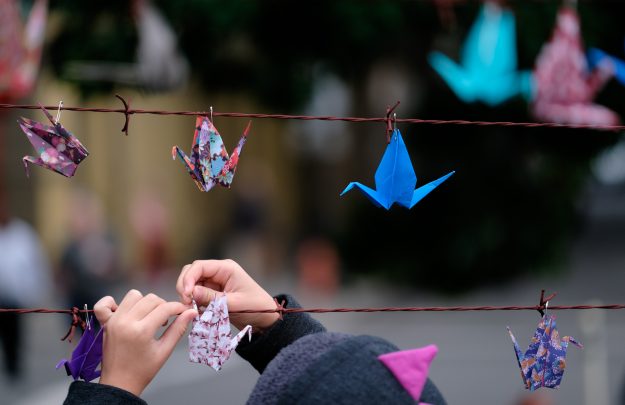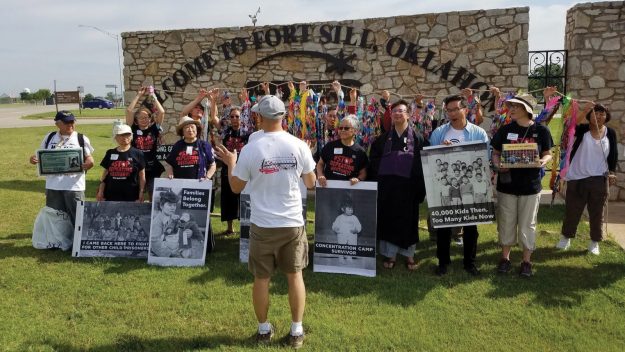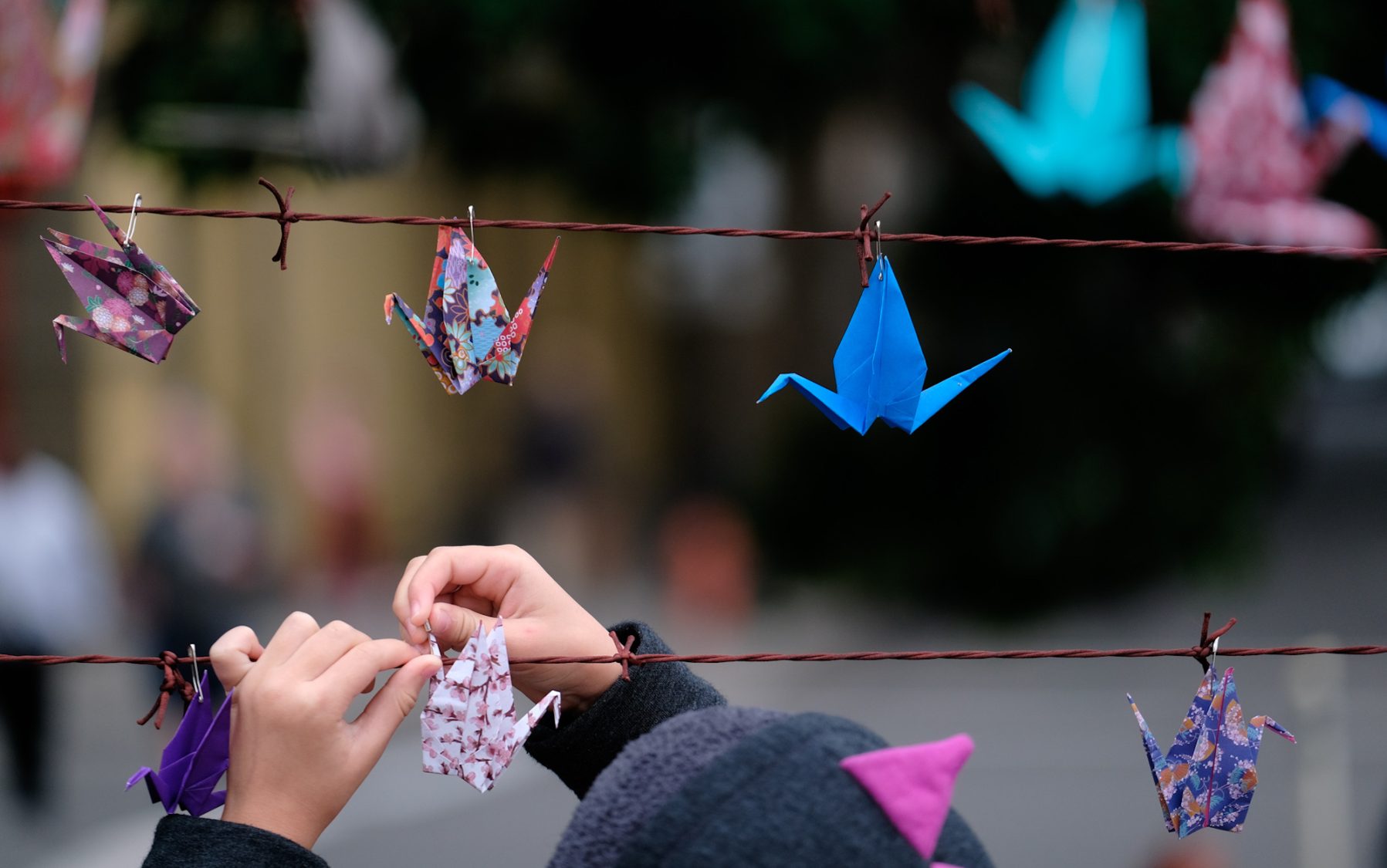The Buddha taught that identity is neither permanent nor disconnected from the realities of other identities. From this vantage point, America is a nation that is always dynamically evolving—a nation of becoming, its composition and character constantly transformed by migrations from many corners of the world, its promise made manifest not by an assertion of a singular or supremacist racial and religious identity, but by the recognition of the interconnected realities of a complex of peoples, cultures, and religions that enrich everyone.
So writes Duncan Ryuken Williams, author of American Sutra, a historical account of the dark chapter in US history when 125,000 Japanese Americans were incarcerated in concentration camps during World War II. In addition to serving as an ordained priest in the Soto Zen Buddhist tradition, Williams is Professor of Religion and East Asian Languages and Cultures at the University of Southern California.
He’s also a member of Tsuru for Solidarity, a group of Japanese American activists who have mobilized to protest the treatment of immigrants both in the United States and at its border. Last summer, the group staged a demonstration at a notorious family detention facility run by Immigration and Customs Enforcement (ICE) in Dilley, Texas. There, they hung more than 25,000 paper cranes—tsuru—on the fence that surrounds the facility, which is just 45 miles from one of the camps where Japanese Americans were interned. As a reporter covering immigration, I’ve been to both sides of the border a number of times in the past few years. Restrictive policies meant to hurt and exclude aren’t new, but the total elimination of compassion toward asylum seekers at our border has been shocking. I spoke with Williams about the work of Tsuru for Solidarity and what a Buddhist ethic of confronting that brutality might look like.
Are there parallels between what happened to Japanese Americans during World War II and how asylum seekers and families trying to immigrate to the US are being treated now? When the internments took place, the US was at war with Italy and Germany. So why was it that only the Japanese American community experienced that kind of mass roundup and incarceration? I think the obvious, simple answer is the racial and religious animus of the time: Buddhism was seen as un-American or even anti-American.
Today, whether it’s with the travel ban or what’s happening at the southern border, there’s still this larger question that my book is trying to tackle, which is about two different visions of America. One says it is essentially and foundationally a white Christian nation. And then there is a different vision that says it’s multiethnic in character and religiously pluralistic.
The struggle Japanese Americans went through back then is interlinked with what’s happening today, where these issues of race and religion—who belongs, who’s included, and who’s excluded—are unfortunately still live questions.
I’ve been contemplating the notion of borders lately, and how they are in some sense a physical manifestation of one approach to identity. What do you think the dharma can teach us about how we approach our national identity? The founder of Soto Zen Buddhism, Master Dogen, wrote a text that says “To study the Buddha’s way is to study the self.” The second line is “To study the self is to forget the self.” And the third line is “To forget the self is to be actualized by the 10,000 things”—a Taoist term referring to everything in the material universe.
What it means is that you are actualized when you recognize that you are made up of everything and that you are not alone. Everything in the world is interconnected. The Buddha taught that anyone who thinks their self is permanent and static as opposed to dynamic and changing is going to fall into suffering, because that’s not how reality actually works.
This means that if we apply the idea of identity beyond one’s self to the world writ large, then we have to take a look at our other identities. What is America? What is Japan, or any place where we say there’s a boundary or a border? When we say there’s an identity that’s set and not subject to change or being interconnected with everything else, we actually create suffering.
As Buddhists we have the responsibility of alleviating that suffering with whatever skillful means we have available to us. So for me, dharma can help us notice that America is not a white Christian nation: it’s actually made up of migrations. There was the westward movement of Europeans, but for Asian Americans our story has been one of eastward movement. For Central Americans, their story is one of movement toward the north.
There’s not just one direction or story of what it means to be American, and until we recognize that America is composed of these different migrations and people interconnecting together in this space, there’s going to be suffering.

Parts of this interdependent soup are fueled by a sense of entitlement and control. How do we confront white supremacy in America? White supremacy is not a new thing. It’s been around in other kinds of immigration policies, starting with the Chinese Exclusion Act of 1882 and going on to the Immigration Act of 1924 and the alien land laws of the early 20th century. This isn’t a new topic. Concerning survival and finding ways to persist, sometimes the best way is to simply create the alternative.
There’s what we might call Anglo-Protestant normativity, where there’s a kind of norm or standard of who is American. When we allow that to remain at the center of the discourse, then it’s all about trying to widen the circles of inclusion. Anglo-Protestants are at the center, while others may be given an opportunity to join that circle.
But what I find, from an Asian American Buddhist perspective, is that we can never join that circle. Buddhism is too far outside the center. It can’t be included in that widening of the circle. So I feel Buddhists have a role to play, as do other Asian-originated religious traditions like Hinduism—not in trying to assimilate into that circle, but rather in creating a different vision of America that is from the start about multiplicity and not singularity, from the start about interdependence, not protection of some kind of purity.
I find that presenting a model of a different way of doing things rather than trying to directly attack the old one can change the discourse and people’s sense of possibility and imagination.
As Buddhists we’re taught that introspection and self-transformation are vehicles of skillful action in the world. But on the other hand there’s a real imperative to do something about what’s surrounding us. How do we strike the right balance? There’s a joke in the Buddhist community that goes, “Don’t just do something, sit there.” The point is that sometimes just sitting there can be doing something very good. It’s not that there’s a one-program-fits-all approach. Some people need to do quiet sitting—maybe that’s their contribution to the world. And for other people there may be more outwardly manifest ways of trying to alleviate suffering.
The Buddhist tradition is so full of amazing teachings on the diversity of medicine that the Buddha, the great physician, gave to people depending on their situation, condition, age, and circumstance. We have a lot of tools we can draw on to take on that big task of alleviating suffering.
The world is so full of what seem like crises, including global climate change. So there are these questions like “Shouldn’t our attention go to that instead of what’s happening at the border?” But everything is interconnected. When you are alleviating suffering in one area, you are inevitably reducing suffering as a whole. What you choose is up to your karmic situation and inclination and temperament. If you do it well, that will have an impact broadly.

I often feel very angry about what’s happening at the border. As practitioners, how do we work with these strong emotions that come up when we see what’s happening in places like Dilley and northern Mexico? There’s a metaphor we often use in Japan, which is a very volcanic country that’s well known for its hot springs. Those hot springs are where volcanic eruptions meet water, which is why they contain different minerals and become healing. If the volcano comes out without any modulation, it can be quite harmful and a lot of destruction can occur. But if you modulate it with some water, then you turn it into something else. It doesn’t disappear, and you aren’t repressing it, but that slight modulation takes the same energy and makes it into something that is beneficial and helpful for beings.
The challenge is to find what will function like the water to modulate our anger, outrage, and disgust—which are all just energies—to help us transform and make the world better. We need to think clearly about what will help make that transformation happen.
That’s a lovely metaphor. Is there such a thing as a Buddhist approach to confrontation? I think there’s a way that we can find the right teachings and practices to engage in confrontation and stand up for people who are suffering, to be in the world in a way that actively advocates for beings regardless of where they come from. But if that’s our mission, the way we engage should align with our path. It’s not like we take up activism and then say, “We’ll get back to Buddhist practice afterward.” We have to do it in a way that is in line with and draws on our teachings, because so many of them allow us to do that kind of modulation work. We’re going to fall off the path, but our practice is to stand up again. When we fall down, we stand back up. The biggest monastery is our world, with all the difficulties and raw emotions it contains.
Working in immigration, I’ve noted that Christian churches have a long history of sheltering immigrants. What do you think we, across the spectrum of American Buddhists, can be doing better? In the long history of Buddhism, there are many great examples of practitioners doing social work and caring for the sick—for example, Buddhist temples taking on the administration of hospitals in medieval Japan, or sanghas in India that cared for the homeless or people affected by natural disasters. In North America, we just don’t have a strong tradition like that, simply because we haven’t been around as long.
An important starting point for us to think about Buddhist involvement in immigration issues would be to contemplate what it means to take refuge, and what it means to provide it. Finding ways to create refuge is actually at the very heart of Buddhism. All the tools are there; we just have to start practicing and honing them so that we really are a religion of refuge. But not out of pity or thinking that we are separate, or different, or above, like we’re looking down on all these poor people. We have to develop a Buddhist ethic of doing this work that isn’t about pitying but simply about recognizing that when we help each other we are contributing to liberation and freedom for all beings, including ourselves.
I have a friend, Reverend William Briones, a third-generation Mexican American serving in Los Angeles at a Hompa Hongwanji Buddhist temple that’s over one hundred years old. The presence of a Latino teacher at a historically Japanese American temple reflects a new configuration of American Buddhism. Similarly, the Orange County Buddhist Church, a Shin Buddhist temple, now has a sizable Latinx membership.
One of the interesting things about American Buddhism is that, in the religion’s 2,500-year history, there was never a time when there were Laotian Buddhists next to Tibetan Buddhists next to all the other lineages of the tradition. We have an opportunity to interlink across communities in a way that never could have happened in all the previous centuries.
In this moment we can create something really exciting and new called American Buddhism, a form that recognizes the multiplicity of lineages, ethnicities, and experiences. As we do that, I think we will organically want to get involved in the issues about immigration, because we will see that they are about us as well.
♦
Before the US outbreak of the novel coronavirus COVID-19, Duncan Ryuken Williams and the group Tsuru for Solidarity had planned to gather in Washington, DC, from June 5 to June 7 for a “National Pilgrimage to Close the Camps.” They were to bring 125,000 paper cranes, representing people of Japanese descent who were interned during World War II, as a symbol of solidarity with immigrant communities. Tsuru for Solidarity postponed these demonstrations until spring 2021 and will instead hold an online gathering in June. Visit the Tsuru for Solidarity’s website for details.
Thank you for subscribing to Tricycle! As a nonprofit, we depend on readers like you to keep Buddhist teachings and practices widely available.
